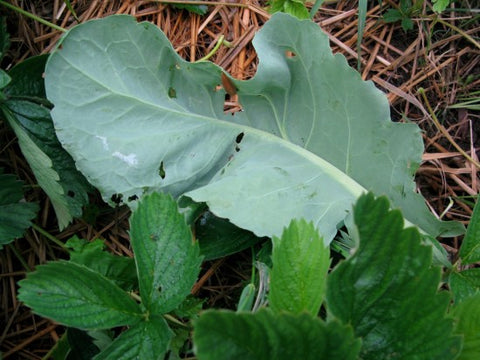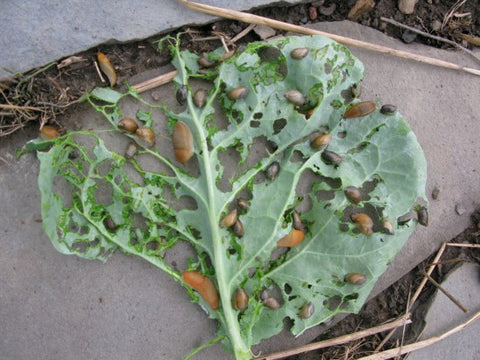They come at night. Waves of them. Well, maybe not waves, but that’s how I envision them…crawling out from beneath their rocks and leaves and massing together to plan their attack. All you’ll see of them in the morning is their wake – bean and lettuce leaves with holes in them, and perfectly ripened strawberries pocked with deep tunnels and slick with slime.
If I’ve learned anything from garden pests, it’s that the first step in controlling them is to know thy enemy. Learn their biology and their behavior and you can usually outwit them. And if you think winning a match of wits against a slug is nothing to boast about, clearly you don’t have any. (Wits or slugs.)
First, Biology: Slugs and snails are part of the mollusk family, and the only real difference between the two is that snails have shells and slugs don’t. And if you have one of the two species, you usually have the other, since they both enjoy the same environments. Their bodies are soft, moist and covered with slime to protect them from drying out and dying. This will be an important fact to remember for your counterattack. Slugs and snails are also hermaphrodites and lay their eggs in the soil in both spring and fall – which is the best time to try some population control since they’re out trying to find a mate. Their eggs can survive for years before hatching, so it’s pretty unlikely that you can ever truly eradicate them. But that’s okay. Like all animals, even slugs have their place. In the wild, they help compost soil. You just don’t need that many of them “helping” you in your garden.
Second, Behavior: Slugs come out in the evening and party until the sun comes up. Like delicate vampires, they must hide during the bright sun of the day and will take shelter under leaves, rocks, and woodpiles. Don’t let their ubiquity fool you. They’re actually not very hardy and are relatively wimpy garden pests. They don’t like their delicate skin irritated or dry. Their strength is merely in their numbers and appetite.
So, knowing all this, how do we control them? How do we stop slugs from eating our strawberries?
Well, first and foremost, keep your garden clean. Fallen leaves and other loose organic matter are slug condos. One of the big advantages of our raised bed garden is that in order to attack our veggies, they need cross pathways of irritating crushed pebbles and climb 2 feet of wood. They’re generally not that tenacious – unless we don’t clear away spent plants that drop leaves and droop over to the ground. This detritus is a safe shady harbor for them, and the drooping stems are a thoroughfare up to the beds. However, our strawberry beds, which are at ground level, are the easiest things in our garden for them to attack. Plus, slugs love strawberries. It’s a deadly combination.
There are basically three ways of controlling slugs and snails: kill ’em, annoy ’em, or lure ’em to their deaths. We find that a combination of all three works best, and here’s how we do it:
- Kill them. The most effective way to kill slugs is to pick them off of leaves and drop them into a pail of salty water. They’ll drown. Use chopsticks (if you’re dexterous enough) so that your fingers don’t get slimy. Some people add dish soap to the water to keep the slugs from climbing back out of the pail, but since we immediately dump the full pail in the chicken coop (chickens LOVE slugs) we don’t add the soap.
If you can’t stomach the thought of hand-picking slugs, ammonia sprayed directly on the slugs also works very well, plus has the added benefit of being a bit of a fertilizer to plant leaves. Simply dilute household ammonia with non-chlorinated water – usually about 1-part ammonia: 7-10 parts water. (If the ammonia concentration is too strong, it can burn tender leaves.) Pour the mixture into a spray bottle and attack. This spraying must be done in early morning or evening when the slugs are actually visible. The ammonia mixture causes the slugs to dissolve. For the particularly vengeful, this is a pleasant way to spend a morning.
There are also natural slug “poisons,” the most well-known of which is a brand named “Sluggo.” Sluggo consists primarily of iron phosphate, which occurs naturally in soil. Sluggo mixes the tiny iron phosphate pellets with an irresistible bait causing the snails to ingest the iron phosphate. This makes them stop eating, and eventually die. Some strict organic gardeners do not like to use Sluggo because although it isn’t a synthetic chemical substance, it unnaturally amends the soil. We wind up using it only during very wet seasons when the slug population explodes.
One inviolate garden rule: if you see a slug, pick it off and stomp on it. This is the most foolproof method.
- Annoy them. Slugs don’t like to be dry or have their skin irritated. Diatomaceous earth or wood ashes sprinkled as a barrier around your beds will persuade slugs to turn around rather than crawl across these scratchy substances. The one drawback to this defense is that it will need to be reapplied after rains that dilute and spread the offending particles.
Another old-fashioned, but trusty method is to lay copper tape or mesh around your beds or plants. Slug and snail slime react with copper to transmit a small electric shock to the slug. It’s like a tiny electric fence. Which is a really satisfying thought.
- Lure them. This is probably the most widely known method for controlling slugs. Slugs like yeast. A lot. So, setting out lures with beer tends to coax them to belly up to the bar in vast numbers. Lures are easy to make from common household objects. Simply sink saucers, tin pie plates, plastic cups, or empty tuna fish cans (into the soil so that at least one side of the rims are level with the ground. Then pour in a little beer (the cheapest brand is fine) and leave out overnight. By morning the containers will be full of slugs. Many of them will not have drowned, however, so the containers must be either capped and thrown away daily, or, as we do, fed to chickens. Don’t just empty them into the trash, or the slugs will simply crawl out and resume their destruction the following evening. Repeat every evening until you find the lures empty in the morning. This is not as onerous as it sounds as long as you bring an extra can of beer along into the garden for yourself.
Other favorite natural lures are inverted citrus rinds and cabbage leaves. Snails flock to them just like the beer saucers. But you’ll have to be extra vigilant about removing the slug-covered rinds and leaves each morning since all this method really does is draw them into one spot away from other plants. Where can you get enough of these food wastes to scatter through your garden? Well, Farmer John’s sister makes a killer coleslaw from scratch. She saves the outer, unusable cabbage leaves for us. Perhaps you have a nearby restaurant or chef who would do the same. Or check your local grocery store or restaurant that squeezes their own fresh orange juice. You can probably get bags of squeezed orange rinds from them.

Scatter cabbage leaves amongst your strawberries or other vulnerable plants in the evening……And you’ll wake up to a slug/snail orgy. This leaf will go right into the chicken coop for their breakfast.

Got any additional snail and slug tips? List them below…